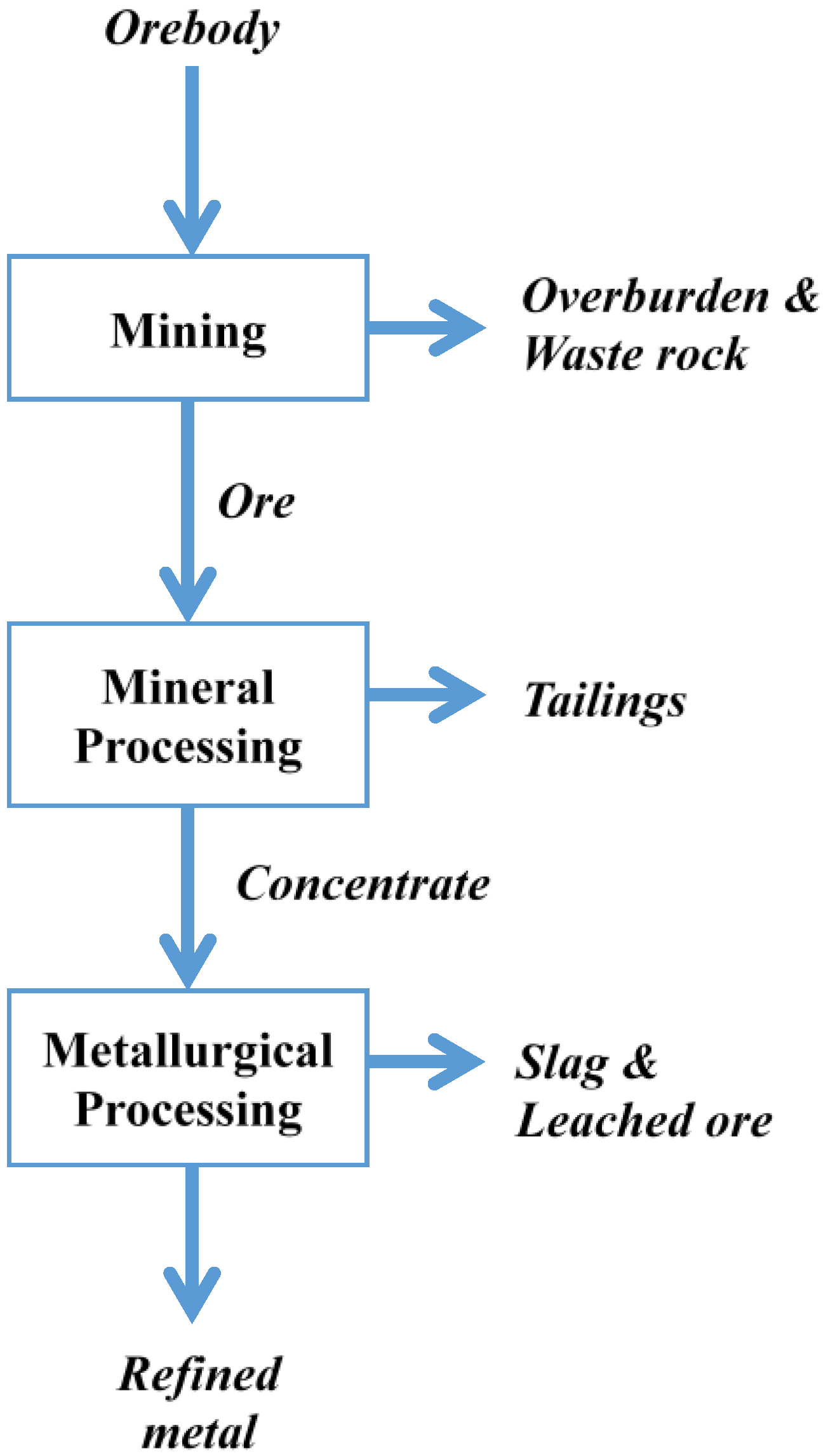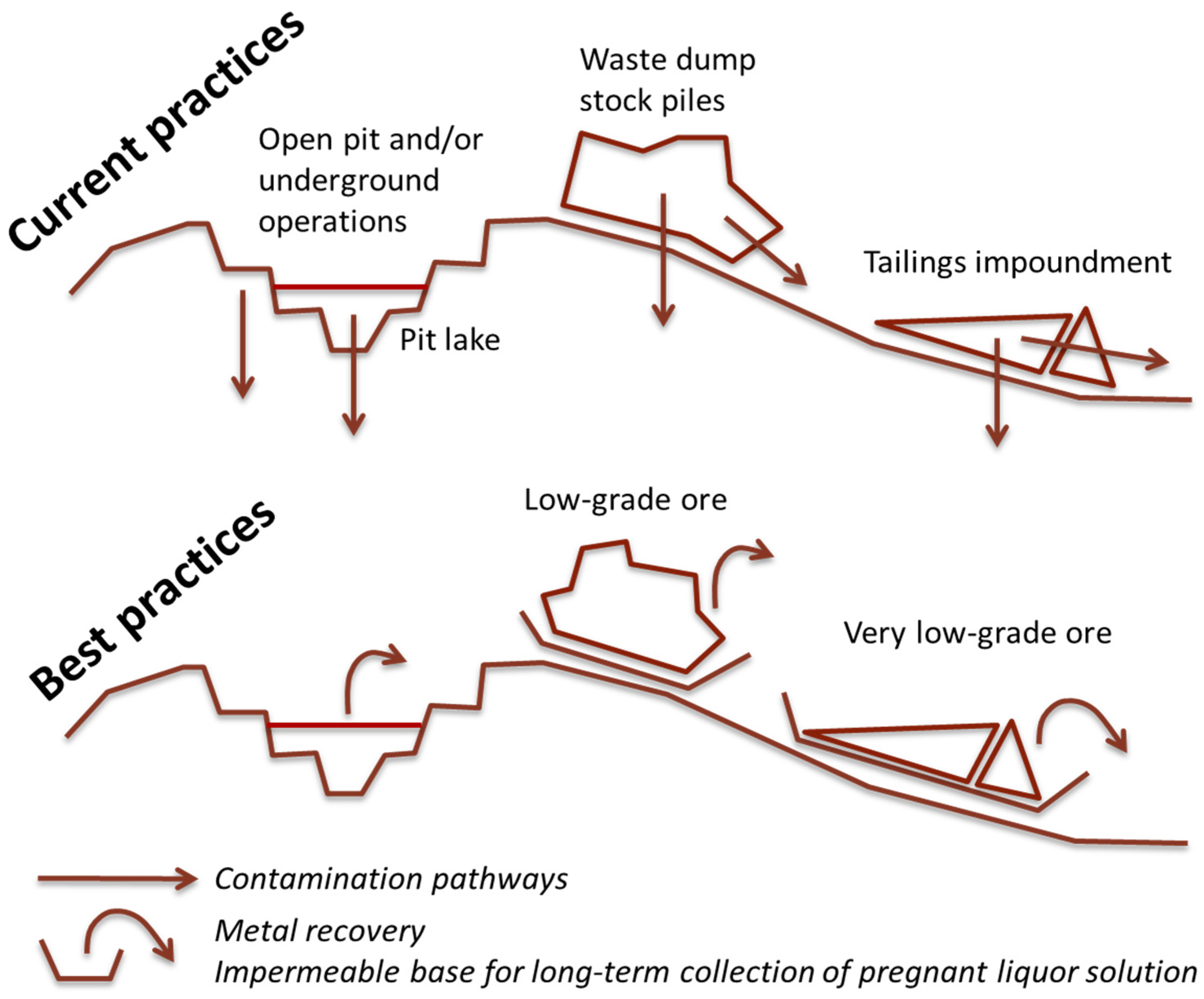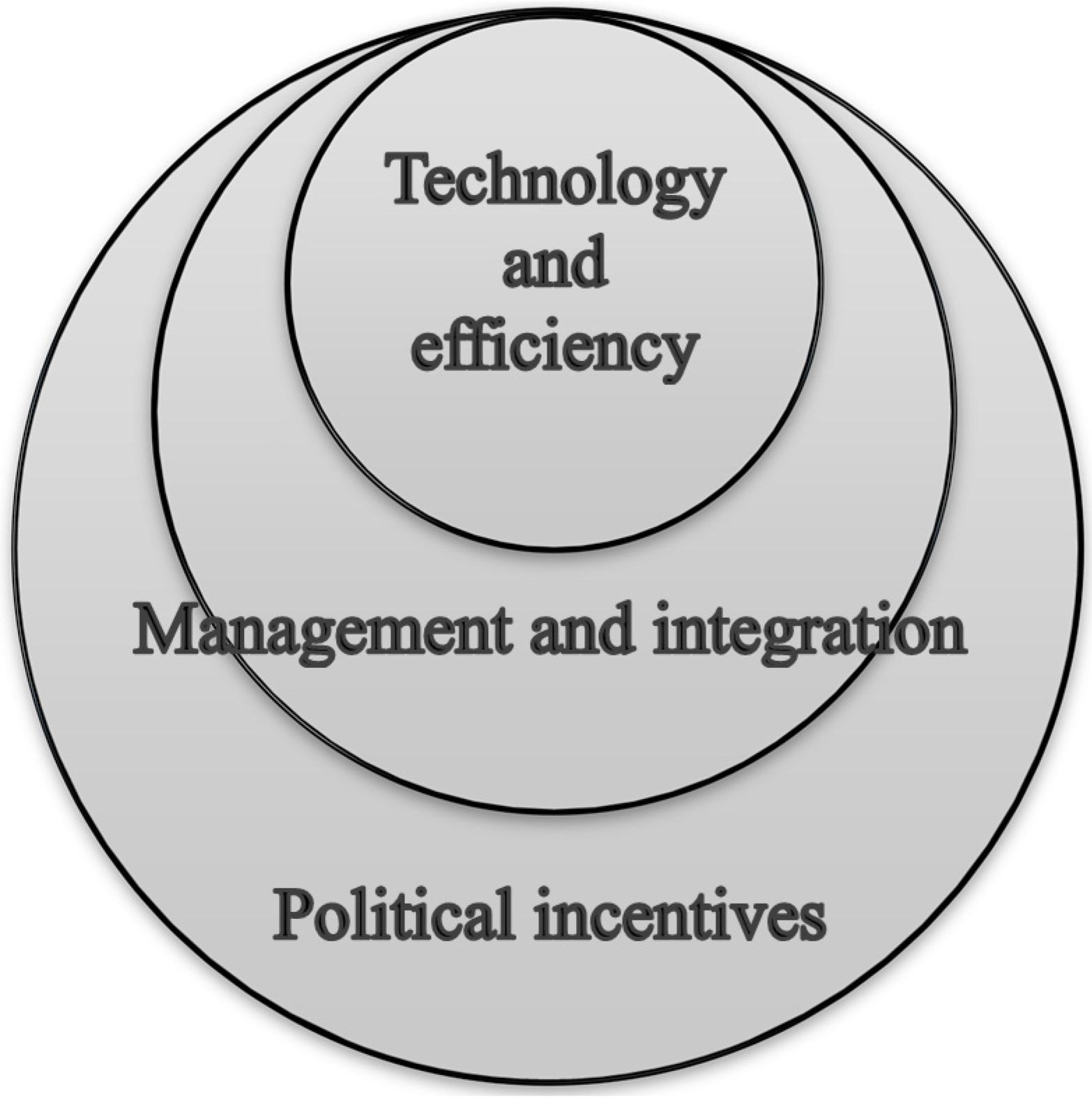Integrating Industrial Ecology Thinking into the Management of Mining Waste
Abstract
:1. Introduction
- Quantify the benefits of a recovery-oriented waste management system; and
- Identify external and internal incentives to facilitate a desirable change in mining practices.
2. The Challenge of Sustainable Mining
2.1. Economic Resource Depletion
2.2. A resilience Problem
2.3. Mining Legacies
2.3.1. How is Mine Waste Generated?

Overburden or Waste Rock
Tailings
Slag and Leached Ore
2.3.2. Mine Waste and Mining Legacies
3. A Potential Solution
3.1. A Preventive and Recovery-Oriented Waste Management

3.2. A New Pyramid of Priorities for Mine Waste Management

4. The Framework
4.1. Three Scenarios to Compare
- Scenario A: a traditional mine produces a certain amount of mineral concentrate P1 while generating an environmental impact E1 during its entire life cycle. After closure the mine legacies generate an additional environmental impact E1′.
- Scenario B: a traditional mine, a certain time after its initial closure is re-opened. The new mine operator decides to re-mine the waste deposits. This second operation leads to an additional production P2 and its related environmental impact E2. In between the two operations, the waste is deposited in the traditional way without planning for future extraction. Examples of case B can be found in practice, such as the large Australian mine sites Kalgoorlie and Mount Morgan.
- Scenario C: an innovative mine site is operated with a planning for future recovery as described earlier. It operates during a certain period, longer than in scenario A and without discontinuation as in scenario B, to produce a final amount of P3 while generating a certain environmental impact E3.

4.2. Quantitative Analysis (Scenarios A and B)
4.3. Qualitative Investigation (Scenarios B and C)
4.3.1. Three Main Scales of Investigation

Technology and Efficiency
Management and Integration
The Role of Policies
5. Conclusions
- Recognises the scarcity of the non-renewable resource by optimising extraction and minimising the amounts of valuable materials in the waste stream;
- And is able to provide long-term social and economic stability to its stakeholders by prolonging and diversifying its operations. This means being resilient to economic changes.
Acknowledgments
Author Contributions
Conflicts of Interest
References
- Dudka, S.; Adriano, D.C. Environmental impact of metal ore mining and processing: A review. J. Environ. Qual. 1997, 26, 590–602. [Google Scholar] [CrossRef]
- Hatayama, H.; Tahara, K.; Daigo, I. Worth of metal gleaning in mining and recycling for mineral conservation. Miner. Eng. 2014, 76, 58–64. [Google Scholar] [CrossRef]
- Norgate, T.E.; Jahanshahi, S.; Rankin, W.J. Assessing the environmental impact of metal production processes. J. Clean. Prod. 2007, 15, 838–848. [Google Scholar] [CrossRef]
- Giurco, D.; Prior, T.; Mudd, G.M.; Mason, L.; Behrisch, J. Peak Minerals in Australia: A Review of Changing Impacts and Benefits; Institute for Sustainable Futures: University of Technology, Sydney, Australia; Department of Civil Engineering: Monash University, Monash, Australia, 2010. [Google Scholar]
- Mason, L.; Prior, T.; Mudd, G.M.; Giurco, D.; Littleboy, A.; Boyle, T.; Fyfe, J.; White, S. Availability, addiction and alternatives: Three criteria for assessing the impact of peak minerals on society. J. Clean. Prod. 2011, 19, 958–966. [Google Scholar] [CrossRef]
- Prior, T.; Giurco, D.; Mudd, G.M.; Mason, L.; Behrisch, J. Resource depletion, peak minerals and the implications for sustainable resource management. Glob. Environ. Chang. 2012, 22, 577–587. [Google Scholar] [CrossRef]
- Meadows, D.; Randers, J.; Meadows, D. Limits to Growth—The 30 Year Update; Earthscan: London, UK, 2005. [Google Scholar]
- Norgate, T.E.; Jahanshahi, S. Low grade ores—Smelt, leach or concentrate? Miner. Eng. 2010, 23, 65–73. [Google Scholar] [CrossRef]
- Gordon, R.B.; Bertram, M.; Graedel, T.E. Metal stocks and sustainability. Proc. Natl. Acad. Sci. 2006, 103, 1209–1214. [Google Scholar] [CrossRef] [PubMed]
- European Commission. Towards a Thematic Strategy on the Sustainable Use of Natural Resources; COM(2003) 572 Final; European Commission: Brussels, Belgium, 2003. [Google Scholar]
- Ayres, R.U. Metals recycling: Economic and environmental implications. Resour. Conserv. Recycl. 1997, 21, 145–173. [Google Scholar] [CrossRef]
- Norgate, T.E.; Lovel, R.R. Water Use in Metal Production: A life Cycle Perspective; Commonwealth Scientific and Industrial Research Organisation (CSIRO): Canberra, Australia, 2004. [Google Scholar]
- Mudd, G.M. The Sustainability of Mining in Australia: Key Production Trends and Their Environmental Implications for the Future; Department of Civil Engineering, Monash University: Monash, Australia; Mineral Policy Institute: Girrawheen, Australia, 2009. [Google Scholar]
- Norgate, T.E.; Haque, N. Energy and greenhouse gas impacts of mining and mineral processing operations. J. Clean. Prod. 2010, 18, 266–274. [Google Scholar] [CrossRef]
- Ayres, R.U.; Ayres, L.W.; Råde, I. The Life Cycle of Copper, Its Co-Products and By-Products; Mining, Minerals and Sustainable Development, International Institute for Environment and Development: London, UK, 2002; p. 210. [Google Scholar]
- Mudd, G.M. Australia’s mining legacies. Arena 2013, 124, 19–24. [Google Scholar]
- Wills, B.A. Wills’ Mineral Processing Technology—An Introduction to the Practical Aspects of Ore Treatment and Mineral Recover, 7th ed.; Butterworth-Heinemann: Oxford, UK, 2006. [Google Scholar]
- Laurence, D. Establishing a sustainable mining operation: An overview. J. Clean. Prod. 2011, 19, 278–284. [Google Scholar] [CrossRef]
- Mining, Minerals and Sustainable Development (MMSD). Breaking new ground: Mining, Minerals and Sustainable Development project; Earthscan Publications Ltd: London, UK, 2002; p. 476. [Google Scholar]
- Moran, C.J.; Kunz, N.C. Sustainability as it pertains to minerals and energy supply and demand: A new interpretative perspective for assessing progress. J. Clean. Prod. 2014, 1–11. [Google Scholar] [CrossRef]
- Walker, B.; Holling, C.S.; Carpenter, S.R.; Kinzig, A. Resilience, adaptability and transformability in social-ecological systems. Ecol. Soc. 2004, 9. Article 5. [Google Scholar]
- Lottermoser, B.G. Mine Wastes: Characterization, Treatment And Environmental Impacts; Springer: Berlin, Germany, 2010. [Google Scholar]
- Wang, T.; Muller, D.B.; Graedel, T.E. Forging the anthropogenic iron cycle-Supporting information. Environ. Sci. Technol. 2007, 41, 5120–5129. [Google Scholar] [CrossRef] [PubMed]
- Worldwatch Institute. Global municipal Solid Waste Continues to Grow. Available online: http://www.worldwatch.org/global-municipal-solid-waste-continues-grow (accessed on 5 April 2015).
- Hudson-Edwards, K.A.; Jamieson, H.E.; Lottermoser, B.G. Mine waste: Present, past and future. Elements 2011, 7, 375–380. [Google Scholar] [CrossRef]
- Bringezu, S. How Much Resource Extraction Would Be Safe? Approaches to Determine a Safe Operating Space of Mineral and Biomass Use. In Proceedings of the Industrial Ecology in the Asia-Pacific Century: Interdisciplinarity science for building sustainable industrial systems and human settlements, Melbourne, Australia, 17–19 November 2014.
- Global Reporting Initiative (GRI). G4—Sustainability Reporting Guidelines. Part 1: Reporting Principles and Standard Disclosures; Global Reporting Initiative (GRI): Amsterdam, The Netherlands, 2013; p. 94. [Google Scholar]
- Brattebø, H.; Røine, K.; Opoku, H.; Ehrenfeld, J.R.; Kjelstrup, S.; Bohne, R.; Skonhoft, A.; Hermansen, J.; Karlsson, S.; Holmberg, J.; et al. Textbook in Industrial Ecology. Introduction to Industrial Ecology—Theory, Methods and Applications; Norwegian University of Science and Technology: Trondheim, Norway, 2007. [Google Scholar]
- Simate, G.S.; Ndlovu, S. Acid mine drainage: Challenges and opportunities. J. Environ. Chem. Eng. 2014, 2, 1785–1803. [Google Scholar] [CrossRef]
- Unger, C.; Lechner, A.M.; Glenn, V.; Edraki, M.; Mulligan, D.R. Mapping and prioritising rehabilitation of abandoned mines in Australia. In Proceedings of the Life-of-Mine Conference, Brisbane, Australia, 10–12 July 2012.
- International Commission On Large Dams (ICOLD). Bulletin 121—Tailings Dams, Risk of Dangerous Occurrences. Lessons Learnt from Practical Experiences; International Commission on Large Dams: Paris, France, 2001. [Google Scholar]
- WISE. Chronology of major tailings dam failures. Available online: http://www. wise-uranium.org/mdaf.html (accessed on 8 April 2015).
- Azam, S.; Li, Q. Tailings dam failures: A review of the last one hundred years. Geotechnical News 2010, 50–53. [Google Scholar]
- Fraser Institute. How are waste materials managed at mine sites? Available online: http://www.miningfacts.org/Environment/How-are-waste-materials-managed-at-mine-sites/ (accessed on 10 April 2015).
- Reid, C.; Becaert, V.; Aubertin, M.; Rosenbaum, R.K.; Deschenes, L. Life cycle assessment of mine tailings management in Canada. J. Clean. Prod. 2009, 17, 471–479. [Google Scholar] [CrossRef]
- Fonseca, A.; McAllister, M.L.; Fitzpatrick, P. Measuring what? A comparative anatomy of five mining sustainability frameworks. Miner. Eng. 2013, 46, 180–186. [Google Scholar] [CrossRef]
- Dold, B. Sustainability in metal mining: From exploration, over processing to mine waste management. Rev. Environ. Sci. Bio/Technol. 2008, 7, 275–285. [Google Scholar] [CrossRef]
- Lottermoser, B.G. Recycling, reuse and rehabilitation of mine wastes. Elements 2011, 7, 405–410. [Google Scholar] [CrossRef]
- Folke, C.; Carpenter, S.; Elmqvist, T.; Gunderson, L.; Holling, C.S.; Walker, B. Resilience and sustainable development: Building adaptive capacity in a world of transformations. AMBIO J. Hum. Environ. 2002, 31, 437–440. [Google Scholar] [CrossRef]
- Boyle, P.; Wilson, G.; Jones, B. Rasp Mine, Zinc-Lead-Silver Project—Waste Management Plan V2; Broken Hill Operations PTY Ltd.: Broken Hill, Australia, 2012. [Google Scholar]
- APS Group Scotland. Guidance on applying the waste hierarchy; The Scottish Government: Edinburgh, UK, 2013; p. 49.
- Van Ewijk, S.; Stegemann, J. Limitations of the waste hierarchy for achieving absolute reductions in material throughput. J. Clean. Prod. 2014. [Google Scholar] [CrossRef]
- Golev, A. Application of industrial ecology principles for enhanced resource efficiency in heavy industrial areas. Ph.D. Thesis, The University of Queensland, St Lucia, Australia, December 2012. [Google Scholar]
- Eurostat. Economy-Wide Material Flow Accounts (Ew-Mfa)—Compilation Guide; European Commission: Brussels, Belgium, 2013. [Google Scholar]
- McLellan, B.C.; Corder, G.D.; Giurco, D.; Green, S. Incorporating sustainable development in the design of mineral processing operations—Review and analysis of current approaches. J. Clean. Prod. 2009, 17, 1414–1425. [Google Scholar] [CrossRef]
- Hilson, G. Defining “cleaner production” and “pollution prevention” in the mining context. Miner. Eng. 2003, 16, 305–321. [Google Scholar] [CrossRef]
- Namboothiri, S.; Taylor, M.P.; Chen, J.J.J.; Hyland, M.M.; Cooksey, M. Aluminium production options with a focus on the use of a hydrogen anode: A review. Asia-Pac. J. Chem. Eng. 2007, 2, 442–447. [Google Scholar] [CrossRef]
- Ayres, R.U.; Ayres, L.W.; Masini, A. An application of exergy accounting to five basic metal industries. Sustain. Met.s Manag. 2006, 19, 141–194. [Google Scholar]
- CRC ORE. Optimising resource extraction—Desktop study of differential blasting potential. Available online: http://www.crcore.org.au/site-studies-new/escondida (accessed on 20 October 2015).
- Steen, J. Digging Deeper into the Productivity Crisis in the Global Mining Industry: Causes and Prospects for Improvement. In Proceedings of the SMI RHD Conference. Resource Extraction: Challenges and Opportunities, Sustainable Minerals Institute, University of Queensland, St Lucia, Australia, 21 November 2014.
- BioteQ. Bioteq, environmental technologies. Key sectors. Available online: http://www.bioteq.ca/key-sectors/#mining (accessed on 20 October 2015).
- Edraki, M.; Baumgartl, T.; Manlapig, E.; Bradshaw, D.; Franks, D.M.; Moran, C.J. Designing mine tailings for better environmental, social and economic outcomes—A review of alternatives approaches. Clean. Prod. 2014, 84, 411–420. [Google Scholar] [CrossRef]
- Mitchell, P.; Steen, J.; Moran, C.J.; Bradbrook, M.; Henderson, C.; MacAulay, S.; Higgins, L.; Kastelle, T.; Kunz, N.C. Productivity in Mining: Now Comes the Hard Part. A Global Survey; Sustainable Minerals Institute, University of Queensland: St Lucia, Australia; Imperial College London: London, UK, 2014. [Google Scholar]
- Topp, V.; Soames, L.; Parham, D.; Bloch, H. Productivity in the Mining Industry: Measurement and Interpretation; Productivity Commission Government of the Commonwealth of Australia: Canberra, Australia, 2008.
- Dobbs, R.; Oppenheim, J.; Kendall, A.; Thompson, F.; Bratt, M.; van der Marel, F. Reverse the curse: Maximizing the Potential of Resource-Driven Economies; McKinsey Global Institute: New York, NY, USA, 2013. [Google Scholar]
- Bringezu, S.; Bleischwitz, R. Sustainable Resource Management: Global Trends, Visions and Policies; Greenleaf Publishing Limited: Sheffield, UK, 2009. [Google Scholar]
- Hilson, G. Barriers to implementing cleaner technologies and cleaner production (CP) practices in the mining industry: A case study of the americas. Miner. Eng. 2000, 13, 699–717. [Google Scholar] [CrossRef]
- Ehrenfeld, J.R. Industrial ecology: A strategic framework for product policy and other sustainable practices. In Proceedings of the Green Goods: The Second International Conference and Workshop on Product Oriented Policy, Stockholm, Sweden, September 1994.
© 2015 by the authors; licensee MDPI, Basel, Switzerland. This article is an open access article distributed under the terms and conditions of the Creative Commons Attribution license (http://creativecommons.org/licenses/by/4.0/).
Share and Cite
Lèbre, É.; Corder, G. Integrating Industrial Ecology Thinking into the Management of Mining Waste. Resources 2015, 4, 765-786. https://doi.org/10.3390/resources4040765
Lèbre É, Corder G. Integrating Industrial Ecology Thinking into the Management of Mining Waste. Resources. 2015; 4(4):765-786. https://doi.org/10.3390/resources4040765
Chicago/Turabian StyleLèbre, Éléonore, and Glen Corder. 2015. "Integrating Industrial Ecology Thinking into the Management of Mining Waste" Resources 4, no. 4: 765-786. https://doi.org/10.3390/resources4040765
APA StyleLèbre, É., & Corder, G. (2015). Integrating Industrial Ecology Thinking into the Management of Mining Waste. Resources, 4(4), 765-786. https://doi.org/10.3390/resources4040765





